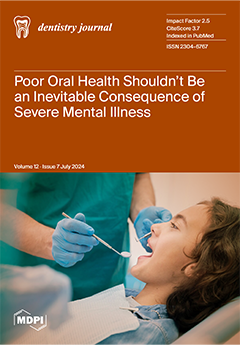Objective: To determine the effect of grit-blasting before and after sintering on the surface roughness of zirconia and the micro-tensile bond strength of a pressable veneering ceramic to zirconia.
Methods: Pre-sintered zirconia blocks (IPS e.max ZirCAD, Ivoclar) were divided into four test groups of three specimens each and a control group (‘CTR’; no surface treatment). Pre-S-30, Pre-S-50, and Pre-S-110 were grit-blasted with 30-µm SiO
2-coated Al
2O
3, 50-µm Al
2O
3 and 110-µm Al
2O
3 particles, respectively, before sintering. Post-S-30 was grit-blasted with 30-µm SiO
2-coated Al
2O
3 after sintering. For each treatment, the surface roughness was measured (Ra, Perthometer M4P, Mahr Perthen). After sintering the zirconia blocks, a liner was applied and a pressable ceramic (IPS e.max ZirPress, Ivoclar) was heat-pressed. Sixteen microbars were obtained from each block and submitted to micro-tensile bond-strength (µTBS) testing. Data were analyzed with one-way ANOVA. Any correlation between Ra and µTBS was evaluated (Sperman test).
Results: Grit-blasting before sintering with 110-µm Al
2O
3 (Ra
Pre-S-110 = 3.4 ± 0.4 µm), 50-µm Al
2O
3 (Ra
Pre-S-50 = 2.3 ± 0.5 µm), and 30-µm SiO
2-coated Al
2O
3 (Ra
Pre-S-30 = 1.2 ± 0.2 µm) resulted in significantly higher roughness than grit-blasting after sintering with 30-µm SiO
2-coated Al
2O
3 (Ra
Post-S-30 = 0.5 ± 0.1 µm). The highest µTBS was measured when the sintered zirconia was grit-blasted with 30-μm SiO
2-coated Al
2O
3 (µTBS
Post-S-30 = 28.5 ± 12.6 MPa), which was significantly different from that of specimens that were grit-blasted before sintering (µTBS
Pre-S-30 = 21.8 ± 10.4; µTBS
Pre-S-50 = 24.1 ± 12.6; µTBS
Pre-S-110 = 26.4 ± 14.1) or were not grit-blasted (µTBS
CTR = 20.2 ± 11.2).
Conclusions: Grit-blasting zirconia before sintering enhanced the surface roughness proportionally to the particle size of the sand used. Grit-blasting with 30-µm SiO
2-coated Al
2O
3 after sintering improved bonding of the veneering ceramic to zirconia.
Clinical Significance: As grit-blasting with 30-µm SiO
2-coated Al
2O
3 after sintering improved bonding of the veneering ceramic to zirconia, it may reduce veneering ceramic fractures/chipping.
Full article






